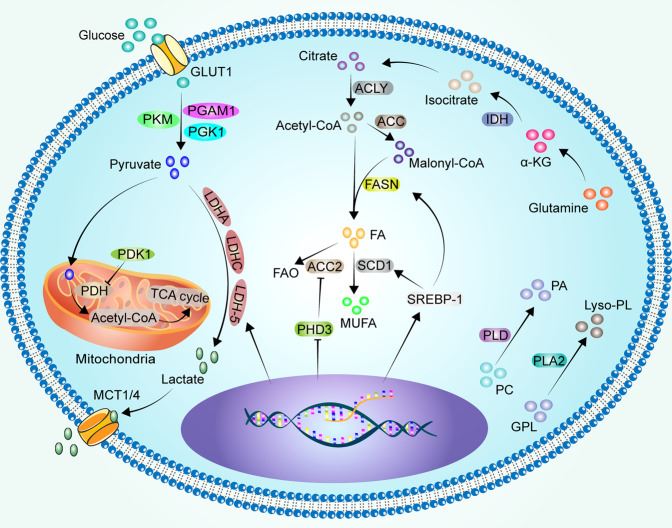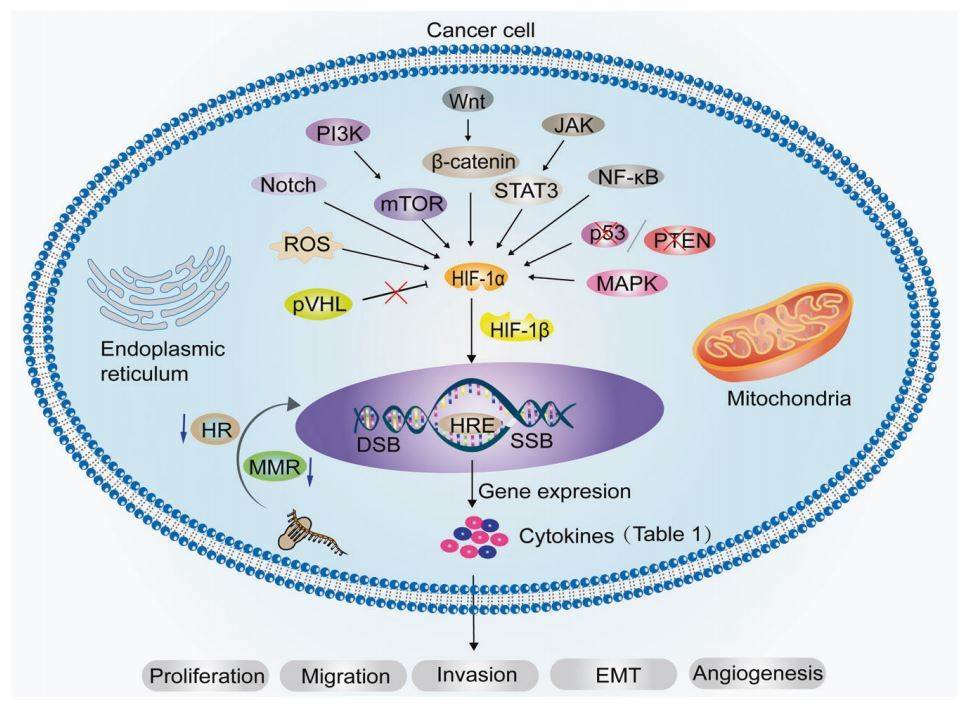Hypoxia Detection Service under Tumor Metabolic Microenvironment
Hypoxia and Tumor Metabolism
The hypoxic state of tumors is difficult to determine due to differences in oxygen content between tissues, differences in tumor size and measurement methods. Creative Biolabs offers you a variety of methods to detect hypoxic status in tumor cells to accelerate your tumor metabolism research.
|
Hypoxia and Tumor Metabolism
|
|
Hypoxia and Glycolysis
|
Most cancer cells increase glucose uptake for glycolysis through the "Warburg effect", which refers to aerobic glycolysis activated by MYC and HIF-1α in response to growth factors and hypoxic conditions to meet the nutrient and energy requirements of rapid genome replication, which is an important tumor metabolic signature.
|
|
Hypoxia and Lipid Metabolism
|
At different stages of cancer development, lipid metabolism is generally enhanced. Under hypoxic stimulation, the activation of FASN can promote lipid synthesis and cell survival. In addition, lipid catabolism also contributes to cancer metastasis, and the main enzymes associated with lipid catabolism in tumor cells under hypoxic conditions are PLA2, PLD, and CPT1. Cancer cells meet their requirements for rapid growth and aggressive development by modulating lipid synthesis/catabolism.
|
 Fig.1 Hypoxia and tumor metabolism.2
Fig.1 Hypoxia and tumor metabolism.2
Our Service
-
Imaging for Tumor Metabolism
Creative Biolabs offers, but is not limited to, the following imaging methods:
Table 1. The hypoxia detection Services. (Creative Biolabs)
|
What Can We Offer
|
Methods
|
|
Biomarkers
|
LM, FM, FC
|
|
Fluorescent Reporter / NTR-sensitive Fluorescence
|
FM, FC, Fluorescent imager
|
|
Phosphorescence CELI
|
FM, Fluorescent imager
|
|
Photoacoustic Imaging (PAI)
|
Ultrasound
|
|
Bioluminescent Imaging (BLI)
|
Luminescent imager
|
|
MRI
|
Proprietary Instrument
|
|
Electron Paramagnetic Resonance Imaging (EPRI)
|
EPRI's proprietary rotary tracer
|
|
PET
|
Radiolabeled Tracers
|
|
Clark Electrode
|
Current meter
|
|
Invasive optical probes
|
Optical Detector
|
Classical imaging
Magnetic resonance imaging (MRI), positron emission tomography (PET), computed tomography (CT).1
Optical imaging
- Near-infrared fluorescence imaging (NIRF) enables non-invasive and real-time visualization of disease-related biomarkers with its specificity and high sensitivity.
- NIRF/PA dual-mode imaging has the complementary advantages of fluorescence and photoacoustic effects, which is expected to improve the imaging output of hypoxia levels in mouse tumors.
- Cherenkov-excited luminescence imaging (CELI) monitors intratumoral hypoxia by releasing visible photons during radiation therapy in combination with phosphorescent probes, such as PtG4.
- The "Clark electrode" O2 sensor is a classic method. It reduces the amount of O2 on the electrode surface by applying a voltage to the electrode, thus distinguishing between induced hyperoxic and hypoxic states.
- Invasive optical O2 sensors are used as a precise method for detecting local O2 concentrations due to their high spatial resolution.
-
Immunolabeling of Markers
In addition to the method above, Creative Biolabs offers a range of assays, including IHC, Western blotting, and ELISA, to examine hypoxia-related biomarkers as well as downstream targets to detect changes in tumor cells.
HIF-1α
The expression of HIF-1α, a major regulator of cellular hypoxic response pathways, was significantly upregulated in a hypoxic environment. Elevated HIF-1α expression suggests that cells or tissues may have been exposed to hypoxia in their model system. HIF-1 activates the expression of a variety of downstream targets. Assessing these downstream targets, as well as HIF-1α, can provide evidence for the presence of hypoxia and oxidative stress in the cell.
 Fig.2 Mechanism of action of HIF-1⍺ in hypoxia.2
Fig.2 Mechanism of action of HIF-1⍺ in hypoxia.2
If you're studying tumor metabolism and need to test the hypoxic status of your cancer cells. Welcome to contact us for further information.
References
-
Momcilovic, M. and David B.S. "Imaging cancer metabolism." Biomolecules & therapeuticsl. (2018): 81-92.
-
Chen, Zhou.; et al. "Hypoxic microenvironment in cancer: molecular mechanisms and therapeutic interventions." Signal transduction and targeted therapy. (2023) 8,1 70.
For Research Use Only | Not For Clinical Use


 Fig.1 Hypoxia and tumor metabolism.2
Fig.1 Hypoxia and tumor metabolism.2
 Fig.2 Mechanism of action of HIF-1⍺ in hypoxia.2
Fig.2 Mechanism of action of HIF-1⍺ in hypoxia.2
 Download our brochure
Download our brochure